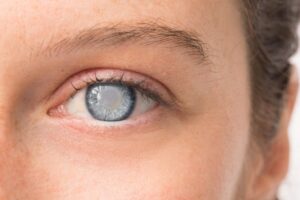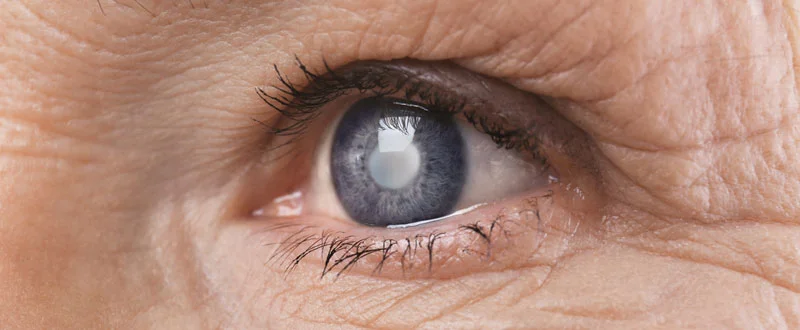If you’re like most people, you probably haven’t given much thought to cataracts. But if you’re over the age of forty, there’s a good chance you’ll eventually develop them. In this blog post, we’ll talk about what cataracts are, how they’re treated, and ways to prevent them from developing in the first place. We’ll also discuss some of the latest research on cataract prevention and treatment. So whether you’re concerned about your own vision or that of a loved one, read on for the information you need to know!
What Is A Cataract?
 A cataract is a clouding of the eye’s lens. The human eye works much like a camera, with a clear lens that helps focus light onto the retina (the film of the eye). When this lens becomes cloudy from a cataract, images become blurry and less bright.
A cataract is a clouding of the eye’s lens. The human eye works much like a camera, with a clear lens that helps focus light onto the retina (the film of the eye). When this lens becomes cloudy from a cataract, images become blurry and less bright.
Cataracts are a very common condition. It is estimated that more than half of Americans age 80 and older have cataracts. Around the globe, it is estimated that there are 2 million people who are blind from cataracts and another 120 million people who have significant vision impairment from cataracts.
This can develop at any age, but most often occur in adults over the age of 40. Infants and young children can also develop cataracts, or be born with them. It usually develops slowly and painlessly, and most people do not notice them until they begin to affect vision.
Types of Cataract
There are different types of cataracts, depending on where they form in the eye:
- Nuclear sclerosis: This is the most common type of cataract. It forms in the central zone (nucleus) of the eye’s lens and makes your vision cloudy, like looking through a piece of frosted glass.
- Cortical cataracts: These form in the lens cortex, which is the part of the eye surrounding the nucleus. They look like spokes on a wheel and can cause your vision to appear streaked.
- Posterior subcapsular cataracts: These form at the back of the lens, just below the capsule that holds it in place. They are often linked with diabetes and high myopia (nearsightedness), and can make reading difficult.
These types of cataracts can occur in one or both eyes. They can also be present at birth, develop over time, or happen suddenly after an injury to the eye. So, if you want help, then do not hesitate to contact a professional for cataract surgery.
Symptoms of Cataracts
The most common symptom of a cataract is blurred vision. Other symptoms may include:
- Colors seem faded
- Glare and halos around lights are more common
- Poor night vision
- Double vision in a single eye
- Frequent changes in eyeglass or contact lens prescription
- The trouble with bright lights and sunlight
Cataracts usually develop slowly and don’t disturb your eyesight early on. You may not even be aware that you have a cataract. But as it grows, it becomes more difficult to read, drive a car or see fine details. A cataract can also make you more sensitive to glare and light.
Also, it is important to note that cataracts are a leading cause of blindness worldwide. According to the World Health Organization (WHO), cataracts are responsible for 51% of all blindness and 33% of visual impairment. In fact, there are an estimated 20 million people who are blind from cataracts and another 120 million people who have significant vision loss due to cataracts.
Causes And Risk Factors
 There are several different types of cataracts, and each has its own set of causes and risk factors. These include:
There are several different types of cataracts, and each has its own set of causes and risk factors. These include:
- Age-related cataracts: This is the most common type of cataract, and it’s simply a result of the aging process. The proteins in your eye’s lens begin to break down and clump together, causing the lens to become cloudy.
- Diabetes: People with diabetes are at a higher risk for developing cataracts, as well as other vision problems.
- Prolonged exposure to UV light: This can damage the proteins in your eye’s lens, and increase your risk of developing cataracts.
- Smoking: Cigarette smoke contains harmful toxins that can damage the eye’s lens and lead to cataracts. It can also cause other vision problems, such as age-related macular degeneration.
- Certain medications: Some medications, such as steroids, can increase your risk of developing cataracts.
- Family history: If you have a family member with cataracts, you may be more likely to develop them yourself.
These are some common causes and risk factors for cataracts, but it’s important to remember that not everyone will develop them. In fact, most people don’t develop cataracts until they’re older. However, if you have any of the risk factors listed above, it’s important to be extra vigilant about protecting your eyesight.
How Is It Diagnosed?
The diagnosis of cataracts is usually pretty straightforward. An eye doctor can perform a vision test and look for signs of cloudiness in the lens. In some cases, special imaging tests may be needed to get a closer look at the lens.
There are some methods of testing the cataract to see how much it has progressed. One is the use of an A-scan, which uses ultrasound waves to measure the length of the eye. This can help determine the power of the lens implant that will be needed after surgery.
Another method used to diagnose cataracts is a B-scan. This uses X-rays to create a cross-sectional image of the eye. This can be helpful in determining if there are any other issues going on in the eye that could be causing symptoms similar to cataracts.
If you are experiencing any vision problems, it is important to see an eye doctor for an evaluation. Many times, cataracts can be treated successfully with surgery. With early diagnosis and treatment, you can help preserve your vision for many years to come.
Cataract Treatment Options
When it comes to cataract treatment, there are a few options available depending on the severity of your cataracts. Some of the common treatments include:
- Cataract surgery: This is the most common and effective treatment for cataracts. During surgery, your doctor will make a small incision in your eye and then remove the clouded lens. They will then replace it with a clear artificial lens.
- Corticosteroid injections: If you have mild cataracts, your doctor may recommend corticosteroid injections. These injections can help reduce inflammation and slow the progression of cataracts.
- Anti-inflammatory eye drops: Another option for mild cataracts is to use anti-inflammatory eye drops. These drops can help reduce inflammation and improve your vision. This can help you avoid surgery for a while.
These treatment options can help improve your vision and quality of life. If you think you may have cataracts, be sure to talk to your doctor about the best treatment option for you.
Cataract surgery is the most common and effective treatment for cataracts. As this works to improve vision, it also becomes important to focus on cataract prevention. As we age, the chances of developing cataracts increase, but there are a few things you can do to help prevent them. So, let’s discuss those in further detail.
Prevention Tips
 There are a few things you can do to help prevent cataracts or delay their progression. These include:
There are a few things you can do to help prevent cataracts or delay their progression. These include:
- Wear sunglasses: Wearing sunglasses can help protect your eyes from the sun’s UV rays. This can help reduce your risk of developing cataracts.
- Eat a healthy diet: Eating a healthy diet that includes plenty of fruits and vegetables can also help reduce your risk of developing cataracts. Antioxidants in particular have been shown to help reduce the risk of cataracts.
- Don’t smoke: Smoking is a leading cause of cataracts, so quitting smoking can help reduce your risk.
- Exercise regularly: Exercise has many benefits for your overall health, and it can also help reduce your risk of developing cataracts.
So, yes prevention is possible with these few tips. But, what if you have cataracts? Fear not, there are treatments that we have discussed above!
Overall, cataract is a common condition that usually occurs with age. However, there are things you can do to help prevent cataracts or delay their progression. If you have cataracts, there are also treatments available to help improve your vision. So if you think you might have cataracts, be sure to talk to your doctor about treatment options.
Conclusion
In conclusion, cataract is a very treatable condition. With early detection and treatment, you can enjoy clear vision for many years to come. If you think you may have a cataract, be sure to see your eye doctor right away. They will be able to diagnose the problem and recommend the best course of treatment for you.
This condition is not an inevitable part of aging and with the right precautions, you can avoid cataracts altogether. Be sure to practice good eye health habits and visit your doctor regularly for check-ups. With a little effort, you can keep your vision clear and enjoy all the beauty life has to offer.
For more information and guidance, please contact Eye Mantra. At EyeMantra we have a team of experienced eye surgeons, who will be happy to answer your any questions on cataract surgery, cataract surgery cost, cataract lens cost for different cataract surgery types- Phacoemulsification, MICS & Femto Laser Cataract . Call us at +91-9711116605 or email at [email protected] for inquiries.


